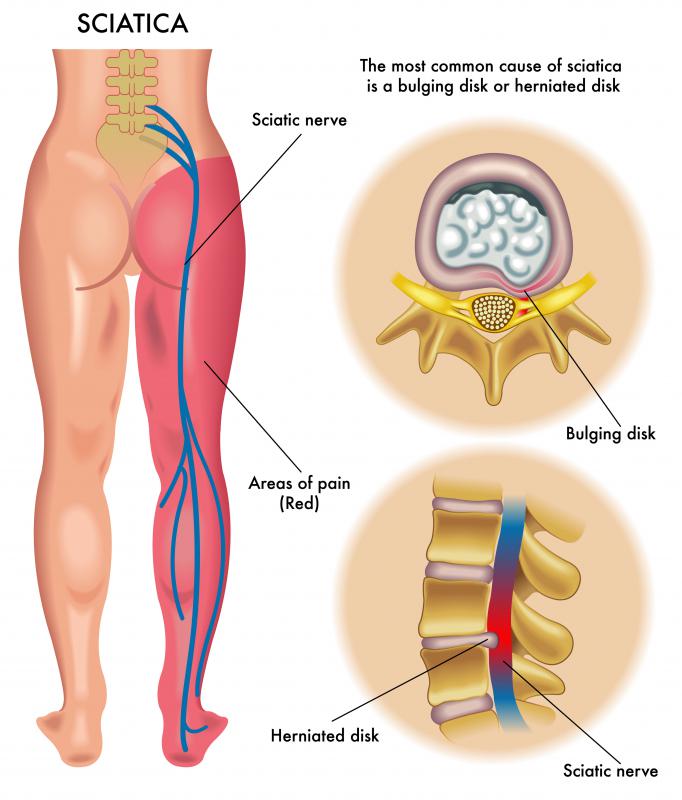At TheHealthBoard, we're committed to delivering accurate, trustworthy information. Our expert-authored content is rigorously fact-checked and sourced from credible authorities. Discover how we uphold the highest standards in providing you with reliable knowledge.
What is a Sciatic Nerve Block?
A sciatic nerve block is an injection given by a medical professional, usually as part of a larger medical procedure, that is designed to temporarily block transmissions and chemical relays related to the sciatic nerve. The sciatic nerve is the body’s longest; it begins in the spine and branches down both legs. People who experience problems anywhere along this nerve pathway often experience a great deal of pain, as well as trouble doing things like stretching in certain ways, walking, and running. A nerve block temporarily relieves pain by reducing or completely dulling the synapses fired by the nerve. Their effects usually last for a number of weeks at a time. They are also commonly used as a means of diagnosing certain conditions, or as a way of blocking pain during procedures like knee surgeries that involve regions that the sciatic nerve crosses through. The procedure itself can be complicated to execute, but isn’t typically very invasive. Patients generally recover very quickly, and the risk of side effects is usually low.
Understanding the Sciatic Nerve

The sciatic nerve is the human body's largest, starting in the lower spinal cord and branching out to extend past both knees in the legs. Pain in the back of the thigh and elsewhere along the sciatic nerve's path can be the result of sciatic nerve irritation and is commonly referred to as sciatica. A doctor can diagnose the condition by observing a patient's symptoms and testing the function of the patient's nerves. X-rays and magnetic resonance imaging (MRI) can also aid in a diagnosis. Blocks are important parts of both pain management and diagnosis in most cases.
The Block Itself

A trapped sciatic nerve can cause radiating pain in the buttocks and back of the legs down to the feet. The blocking injection usually contains both an anesthetic and a steroid, the first to deal with the discomfort of the injection itself and the second to actually treat the condition. Like all nerve blocks, a sciatic block works by preventing the nerve from sending pain messages to the brain. It’s important to note here that the injection doesn’t actually cure the problem. The underlying issue with the nerve, whether it’s pinched or trapped or inflamed, remains, but the patient no longer suffers because of it.
Relief for Trapped Nerves

People who suffer from chronic sciatica are often good candidates for nerve block therapy. In these instances, the block is administered on a somewhat routine basis, maybe once a month or once a quarter, depending on how bad the pain is. It’s usually best for the injections to be just one part of a larger therapy plan, and in most cases they’re used as something of a “last resort” — they are a somewhat serious solution, and can also be quite expensive. They’re usually only recommended in instances when nothing else is working.
Other Diagnostic and Surgical Uses

A sciatic nerve block also can be used as a diagnostic tool. It’s usually given once and, if the pain disappears shortly thereafter, it is assumed that the diagnosis of sciatica is accurate. The procedure can reduce pain in other situations, too. Doctors frequently use a temporary nerve block when performing knee or foot surgery, for instance. It is considered to be a beneficial procedure because it limits the need for other painkillers, such as morphine, both during and after surgery.
Recovery and Related Risks

A sciatic nerve block usually has a short recovery period and is less invasive than most surgeries. It remains similar to other medical procedures, however, in that it also has risk factors and the potential for complications. These include infection, allergic reaction, and a possibility of increased pain if the nerve block proves unsuccessful.
AS FEATURED ON:
AS FEATURED ON:















Discussion Comments
Can you have an allergic reaction to nerve block medication injected for the sciatic nerve?
Post your comments